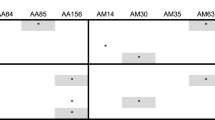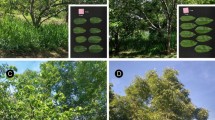Abstract
The main characteristics (plant diameter, number of spine/areoles and length of spines) of 16 cactus hybrids were analysed and the genetic variability and broad-sense heritability was studied. The descendants were obtained through a cyclic cross-pollination pattern, with the parental forms chosen based on aesthetic considerations. Cross-pollination among Rebutia senilis × Aylostera muscula, Rebutia tarvitaensis × Aylostera muscula, Aylostera flavistyla × Rebutia senilis, Rebutia senilis × Aylostera flavistyla, Aylostera muscula × Aylostera albiflora and Rebutia senilis × Aylostera albiflora did not succeed, whereas all of the other hand-pollinated crosses succeeded and produced viable seeds. The highest values of the analysed characters were observed in the progeny of A. fiebrigii var. densiseta × R. senilis and A. buiningiana × A. vallegardensis and the artificial selection to identify plants with special decorative traits was extremely efficient among them. In the F1 population of the studied crosses, a large genetic diversity was found within hybrid combinations (families), between combinations and a different variation was recorded among the analysed traits. The broad-sense heritability ranged between 0.909 (plant diameter) and 0.948 (spines length). All of the characters analysed, in the present experience, have a strong genetic determinism, being greatly influenced by the genotype and to a lesser extent, by the cultivation conditions (greenhouse).


Similar content being viewed by others
References
Backeberg C (1968–1977) Das Kaktenlexicon. Veb Gustav Fischer, Verlang Jena
Boyle TH (1997) The genetics of self-incompatibility in the genus Schlumbergera (Cactaceae). J Hered 88:209–214
Boyle TH, Anderson EF (2002) Biodiversity and conservation. In: Nobel PS (ed) Cacti: biology and uses. University of California Press, Berkeley, pp 125–141
Boyle TH, Menalled FD, O’Leary MC (1994) The occurrence and physiological breakdown of self-incompatibility in Easter cactus. J Am Soc Hortic Sci 119:1060–1067
Burd M (1998) “Excess” flower production and selective fruit abortion: a model of potential benefits. Ecology 79:2123–2132. doi:10.1890/0012-9658(1998)079[2123:EFPASF
Casas A, Valiente-Banuet A, Rojas-Martinez A, Davila P (1999) Second generation experimental hybridizations in the Echinocereus × Lloydii complex (Cactaceae), and further documentation of dioecy in E-Coccineus. Am J Bot 864:534–542. doi:10.1007/BF00985335
Figueredo CJ, Nassar JM, García-Rivas AE, González-Carcacía JA (2010) Population genetic diversity and structure of Pilosocereus tillianus (Cactaceae, Cereeae), a columnar cactus endemic to the Venezuelan Andes. J Arid Environ 74(11):1392–1398. doi:10.1016/j.jaridenv.2010.05.020
Gordon IL (1999) Quantitative genetics of intraspecies hybrids. Heredity 83:757–764
Hentzschel G, Hentzschel K (2001) Sulcorebutia or Rebutia?. Cactus Succul J 73(5):237–242
Hewitt T (1993). The complete book of cacti and succulents: the definitive practical guide to cultivation, propagation, and display, 1st Canadian Ed, Canada
Holland JB, Nyquist WE, Cervantes-Martinez CT (2003) Estimating and interpreting heritability for plant breeding: an update. Plant Breed Rev 22:9–112. doi:10.1002/9780470650202.ch2
IUCN (2008) The international union for conservation of nature. http://www.iucn.org/
Leite MSO, Peternelli LA, Barbosa MHP (2006) Effects of plot size on the estimation of genetic parameters in sugarcane families. Crop Breed Appl Biotechnol 6:40–46. doi:10.1590/S0100-204X2009001200002
Lichtenzveig J, Abbo S, Nerd A, Tel-Zur N, Mizrahi Y (2000) Cytology and mating systems in the climbing cacti Hylocereus and Selenicereus. Am J Bot 87:1058–1065
Loik ME, Nobel PS (1991) Water relations and mucopolysaccharide increases for a winter hardy cactus during acclimation to subzero temperatures. Oecologia 88:340–346. doi:10.1007/BF00317576
Machado MC (2008) What is the role of hybridization in the evolution of the Cactaceae? Bradleya 26:1–18
McIntosh ME (2002) Plant size, breeding system, and limits to reproductive success in two sister species of Ferocactus (Cactaceae). Plant Ecol 162:273–288. doi:10.1023/A:1020329718917
Meier E (1995) Easter cacti (Rhipsalidopsis; Cactaceae). Haseltonia 3:10–24
Mihalte L, Sestras R, Feszt G, Vilcan A (2009) The variability of seeds weight and germination percentage of different Cactaceae genera (Aylostera, Mediolobivia, Rebutia and Sulcorebutia). Bulletin of UASVM Cluj-Napoca. Horticulture 66(2):66–74
Mihalte L, Sestras RE, Feszt G, Sestras AF (2010) Variability of seed traits in interspecific and inter-generic combinations between different genotypes of Cactaceae. Not Bot Horti Agrobo 38(3):246–252
Mondragon-Jacobo C, Bordelon BB (1996) Cactus pear (Opuntia ssp.) breeding for fruit production. J Prof Assoc Cactus 1:19–35
Nobel PS (2002) Cacti, biology and uses. Cambridge University Press, New York
Oldfield S (1997) Cactus and succulent plants: status survey and conservation action plan. IUCN/SSC cactus and succulent specialist group. International Union for Conservation of Nature and Natural Resources. Gland, Switzerland and Cambridge
Ortega-Baes P, Aparicio-Gonzalez M, Galindez G, Del Fueyo P, Suhring S, Rojas-Arechiga M (2010) Are cactus growth forms related to germination responses to light? A test using Echinopsis species. Acta Oecol Intern J Ecol 36(3):339–342. doi:10.1016/j.actao.2010.02.006
Oyiga BC, Uguru MI, Aruah CB (2010) Pollen behaviour and fertilization impairment in Bambara groundnut (Vigna subterrenea [L.] Verdc.). J Plant Breed Crop Sci 2(1):12–23
Parish J, Felker P (1995) Evaluation of fruit quality and production of cold-hardy Opuntia fruit clones. In: Felker P, Moss J (eds) Kingsville professional association for cactus development first annual conference, Texas, pp 12a–12e
Parra F, Casas A, Peñaloza-Ramírez JM, Cortés-Palomec AC, Rocha-Ramírez V, González-Rodríguez A (2010) Evolution under domestication: ongoing artificial selection and divergence of wild and managed Stenocereus pruinosus (Cactaceae) populations in the Tehuacán Valley, Mexico. Ann Bot 106(30):483–496
Peharec P, Posilović H, Balen B, Krsnik-Rasol M (2010) Spine micromorphology of normal and hyperhydric Mammillaria gracilis Pfeiff. (Cactaceae) shoot. J Microsc 239(1):78–86
Piepho HP, Möhring J (2007) Computing heritability and selection response from unbalanced plant breeding trials. Genetics 177(3):1881–1888. doi:10.1534/genetics.107.074229
Pilbeam J (1997) The cactus file handbook 2. Rebutia, Ciro Publishing Services Ltd., pp 73–87
Reed GF, Lynn F, Meade BD (2002) Use of coefficient of variation in assessing variability of quantitative assays. Clin Diagn Lab Immunol 9(6):1235–1239. doi:10.1128/CDLI.10.6.1162.2003
Sestras RE, Moldovan SD, Popescu CF (2008) Variability and heritability of several important traits for grape production and breeding. Not Bot Horti Agrobo 36(1):88–97
Sestras RE, Pamfil D, Sestras A, Jäntschi L, Bolboaca SD, Dan C (2009) Inheritance of vigor tree in F1 apple interspecific hybrids. Not Bot Horti Agrobo 37(1):70–73
Tel-Zur N, Abbo S, Bar-Zvi D, Mizrahi Y (2003) Chromosome doubling in vine cacti hybrids. J Hered 94(4):329–333
Wang X, Felker P, Burow MD, Paterson AH (1998) Comparison of RAPD marker patterns to morphological and physiological data in the classification of Opuntia accessions. J Prof Assoc Cactus 3:3–14
Zak MR, Cabido M, Hodgson JG (2004) Do subtropical seasonal forests in the Gran Chaco, Argentina, have a future? Biol Conserv 120:589–598. doi:10.1016/j.biocon.2004.03.034
Acknowledgments
This study was financed by the POSDRU/89/1.5/S/62371 project („Postdoctoral School of Agriculture and Veterinary Medicine”, Romania).
Author information
Authors and Affiliations
Corresponding author
Rights and permissions
About this article
Cite this article
Mihalte, L., Sestras, R.E. The plant size and the spine characteristics of the first generation progeny obtained through the cross-pollination of different genotypes of Cactaceae. Euphytica 184, 369–376 (2012). https://doi.org/10.1007/s10681-011-0597-5
Received:
Accepted:
Published:
Issue Date:
DOI: https://doi.org/10.1007/s10681-011-0597-5




